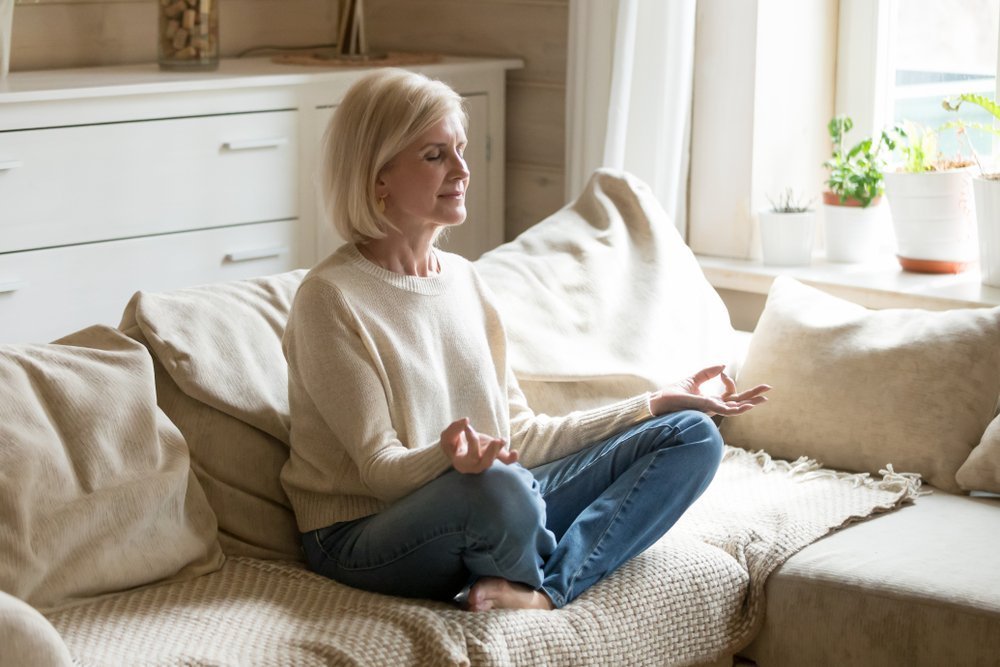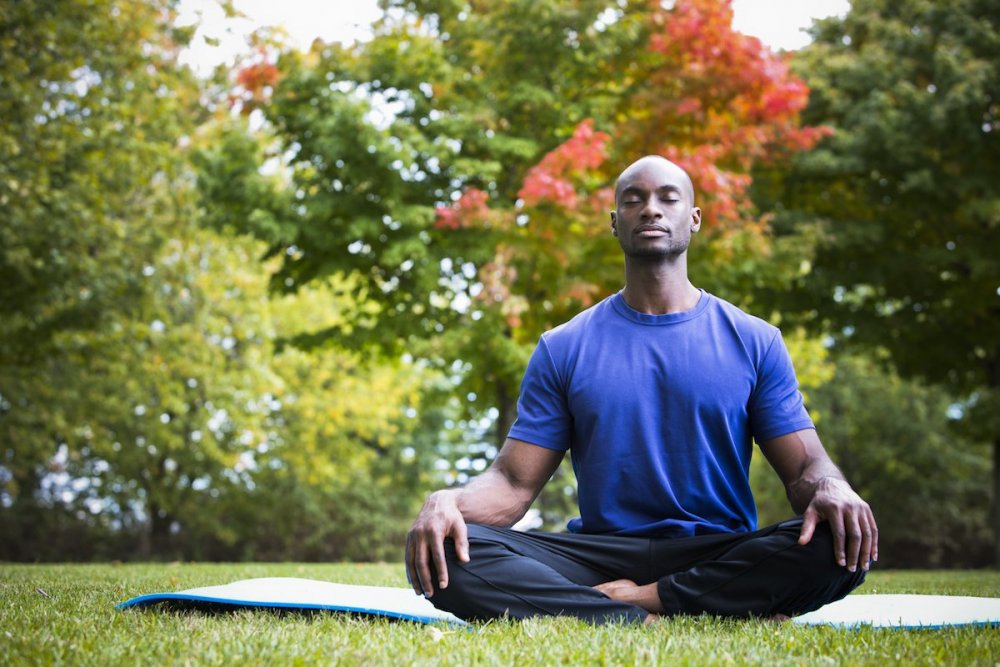The benefits of Vedic meditation are many: improved sleep, clearer thought, and lowered stress. Meditation teacher Ann Vrlak explains how to practise this ancient meditative form and guides you on the power of the vedic meditation mantra.
Vedic meditation is an ancient form of meditation practice – in fact, it’s the very first. The many styles of meditation that you see today all originated from this original practice. The source of Vedic meditation is the Vedas, a series of texts that form the basis of Indian philosophy, all branches of yoga, and the science of Ayurvedic medicine. For centuries, all three of these disciplines have had an enormous impact on people’s health and well-being around the world.
The Vedas lay out a comprehensive path to a happy and meaningful life through experiential learning. When you practise Vedic meditation, you will go on a journey of self-discovery and apply what you learn to all aspects of your daily living.
So, what is Vedic meditation?
Vedic meditation is centred on a mantra – a phrase that is repeated either out loud or silently in your mind. “Mantra” is made up of two Sanskrit words: “man” which means mind, and “tra” which means vehicle or transport.
So, a vedic meditation mantra is a vehicle to take your mind from one place to another: perhaps from the busy activity of your day-to-day mind to a deeper, quieter place, that is often covered up by that activity.

Vedic meditation uses mantras, and can be done at home
The most ancient mantras are in the Sanskrit language because Sanskrit is what’s known as a ‘vibrational’ language. What does that mean exactly? It means that the sound of the words, their vibrations, create the experience of the words’ meaning.
For example, the Sanskrit word for peace is “shanti.” It’s said that when “shanti” is repeated, the sound itself invokes the feeling of peace. Or when the word for compassion, “karuna,” is repeated, you will be filled with a feeling of compassion.
“When you practise Vedic meditation, you will go on a journey of self-discovery and apply what you learn to all aspects of your daily living.”
And you probably already had experiences of how relaxing sounds can be. The sound of a running river. Or birds singing. In fact, you don’t relax through thinking about the river or the bird, but from the sounds themselves. Similarly, using a vedic mantra meditation gives your brain something innately healthy to focus on – a break from a busy mind.
RELATED: What Is a Sound Bath Meditation and What Are Its Benefits?
It’s worth pointing out that Vedic meditation also helps you to be more mindful and do one thing at a time (something which is deeply calming). Indeed, studies have shown that multitasking is actually stressful for our minds and bodies and, in fact, it may not even be truly possible.
What are the benefits of vedic meditation?
So, before explaining how to practise Vedic meditation with mantras, let’s take a look at its main benefits. If you feel you are healthy, what would that look like to you? A generally healthy person would:
-
Sleep well Vedic meditation nurtures a healthy nervous system. It activates your parasympathetic nervous system, the part of your body that governs relaxation and rejuvenation. Additionally, it helps to reduce stress chemicals that accumulate in your body, and allows a deeper, more restful sleep.
-
Feel relaxed and be able to relax when needed Anxiety and stress are epidemics in our modern world. The relaxing effects of vedic meditation can be used any time you’re aware of being anxious or stressed. And the healing, anti-anxiety effects build over time and lower your overall stress level.
-
Think clearly and creatively Have you ever noticed that when you’re anxious it’s hard to think? The ability to relax in the moment and have a generally low stress level allows your brain to work better. Areas across your brain work together more efficiently so you are more creative and productive. When your nervous system is rejuvenated, you have more resources at your fingertips to respond to your life wisely and compassionately.
-
Be emotionally balanced and calm Your emotions have physical and mental components that can become a vicious cycle, creating upset or intense suffering. Just as your thinking becomes clearer and more holistic through vedic meditation, your emotions also become clearer and more grounded.
-
Have all the energy you need Because Vedic meditation activates the rest and rejuvenate part of your brain, because you’re sleeping well, and because you’re reducing your stress level, your energy levels should soar.
- Be content Taken all together, doesn’t this sound like a recipe for contentment? You are physically rested and relaxed, and your thinking and emotions are clear and calm, supporting you in your best intentions. All of these things make your connections and relationships with people easier and more fulfilling. And, you have energy for the things that matter to you most.
How to practise vedic meditation
First, it’s important to know you don’t need any religious or spiritual belief to do Vedic meditation. All you need is a mantra, a few minutes of quiet, and a spirit of adventure.
As I mentioned earlier, traditional mantras are in Sanskrit. Give one of the vedic meditation mantras below a try. If for any reason you’re not comfortable with them, you can use words in your own language, like “peace” or “compassion.”
How to do vedic meditation in 6 steps
Decide on a length of time to practice and do your best to stick to it. You can start with 10 minutes and build up to 40.
1. Choose your mantra. Here are a few traditional Sanskrit mantras
OM. The primordial mantra, the sound of the universe or, in Indian philosophy, the sound of pure consciousness. Repeating this mantra can help you let go of personal worries and connect with the universal sound.
SO HUM is another ancient mantra which means 'I am that'. Not only can you connect with pure consciousness, you can experience yourself as that consciousness.
OM MANI PADME HUM is a lovely mantra meaning “the jewel in the lotus.” Lotus flowers grow in mud. This mantra invokes your power of transformation, your ability to overcome things and find the jewel in difficulty.
2. Find a quiet space
When you’re first learning any kind of meditation, it’s best to take time away from your usual daily activities in a quiet space. It can be as simple as a comfortable cushion or chair in the corner of a room. As you become more experienced, it will be easier to close your eyes for a few minutes of practice wherever you are.
 Find a quiet spot to practise vedic meditation
Find a quiet spot to practise vedic meditation
3. Sit and connect with your body
Take a comfortable sitting posture, physically relax as much as you can, and let your attention gently scan your body. Take a few deep breaths, letting go a bit of any tension or stress each time you exhale.
4. Use your mantra
Bring your mantra to mind and, if you like, its meaning as well. Know there’s nothing you need to do or create; you’re simply repeating your chosen mantra. Start by repeating it softly, out loud. Focus on the feeling of the sound, how the vibrations feel in your throat, your heart, your stomach – wherever you feel it most.
“Using vedic meditation mantras nurtures a healthy nervous system and helps to reduce stress chemicals. It also allows a deeper, more restful sleep.”
When you find that your attention has drifted to a memory or a plan or anything else, that’s all part of the practice. Notice where your attention is and gently come back to repeating your mantra. After a moment or two, start to repeat the mantra more and more quietly, until you're repeating it silently inside.
RELATED:
- Turning Pain Into Compassion: Tonglen Meditation
- 9 Science-Backed Benefits of Meditation
-
Does Meditation Really Work? Here's What Science Says
If you like, you can lengthen the silence between the repetitions, with the mantra coming out of and going back in to silence. If you find you become distracted in longer silences, come back to repeating the mantra more often.
5. Returning to body awareness
When your practice time is almost done, let go of the mantra and bring your attention back to the physical sensations in your body. Again, gently scan your body and notice if areas of your body feel different than before. Also, notice the state of your mind and your emotions. There’s no right or wrong way to feel, just notice what is here for you.
6. Close with a breath
When you’re ready, end with another few deep, relaxing breaths.
The takeaway: what is vedic meditation?
Just like any other activity or skill you learn, getting the full benefits of vedic meditation and mantras takes time. However, by practising it you will become sensitive to subtle body, mind and emotional states – becoming a keen observer of yourself. Indeed, you may notice quite quickly small shifts in your stress level, mood and well-being as you practice.
And, you may find, like so many people do, that the act of vedic meditation itself creates an oasis where you experience just a little more relaxation, a little more contentment, and a little more joy. A little of any of these experiences goes a long way in improving your happiness levels! ●
Images: shutterstock/Zdenka Darula, shutterstock/fizkes
happiness.com | The fine art of being: learn, practice, share
Are you a happiness.com member? Sign up for free now to:
■ enjoy our happiness magazine
■ share and support in our happiness forum
Gratitude | Acceptance | Altruism | Volunteering
Written by Ann Vrlak
 Ann Vrlak is Founder of OneSelf Meditation and a meditation practitioner for over 25 years. She’s a Certified Meditation Teacher for adults and for children (the best job ever!). She loves to share how the perspective and practice of meditation can support people with their everyday stresses and on their journey of self-discovery.
Ann Vrlak is Founder of OneSelf Meditation and a meditation practitioner for over 25 years. She’s a Certified Meditation Teacher for adults and for children (the best job ever!). She loves to share how the perspective and practice of meditation can support people with their everyday stresses and on their journey of self-discovery.



Join the conversation
You are posting as a guest. If you have an account, sign in now to post with your account.